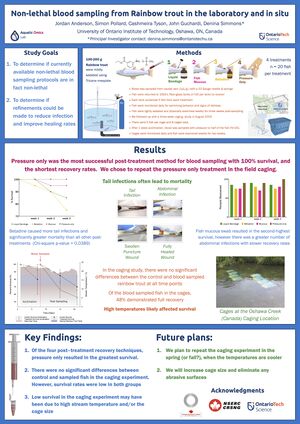Difference between revisions of "Blood sampling of rainbow trout"
Werenskjold (talk | contribs) |
m |
||
| (One intermediate revision by the same user not shown) | |||
| Line 10: | Line 10: | ||
Overall, we observed 90% survival among all treatments; the most effective approach was the pressure-only (100% survival), while the post-treatment with the largest impact on fish survival was the use of betadine (75% survival). | Overall, we observed 90% survival among all treatments; the most effective approach was the pressure-only (100% survival), while the post-treatment with the largest impact on fish survival was the use of betadine (75% survival). | ||
| + | |||
| + | This study has now been [https://www.frontiersin.org/research-topics/18470/non-lethal-animal-methods-in-environmental-toxicology published under Open Access]. The paper was part of a larger special topic on [https://www.frontiersin.org/research-topics/18470/non-lethal-animal-methods-in-environmental-toxicology non-lethal methods in environmental toxicology]. | ||
| + | [[File:Anderson_et_al_Non_lethal_blood_sampling_rainbow_trout_poster.jpg|alt=|center|frameless]] | ||
| + | |||
We plan to repeat this test in the natural environment, and will post more information later. | We plan to repeat this test in the natural environment, and will post more information later. | ||
| − | |||
The poster may be [[:File:Anderson et al blood sampling rainbow trout.pdf|downloaded as a pdf file here]].<br /> | The poster may be [[:File:Anderson et al blood sampling rainbow trout.pdf|downloaded as a pdf file here]].<br /> | ||
Latest revision as of 06:55, 31 May 2022
Poster Title: Non-lethal blood sampling from Rainbow trout in the laboratory and in situ
Co-authors: J. Anderson, S. Pollard, C.D. Tyson, J. Guchardi, D.B.D. Simmons
Aquatic Omics Lab, Ontario Tech University, Oshawa, ON, Canada
The use of humane methods in animal research is an internationally recognized priority, but few Environmental Effects Monitoring programs use non-lethal methods with fish, and the ones that do are normally limited to behaviour, morphology and reproduction.
The goal of the study shown in this poster was to determine the impacts and survival of larger bodied fish after sampling small volumes of blood for the purpose of using non-lethal methods in Environment Effects Monitoring.
Overall, we observed 90% survival among all treatments; the most effective approach was the pressure-only (100% survival), while the post-treatment with the largest impact on fish survival was the use of betadine (75% survival).
This study has now been published under Open Access. The paper was part of a larger special topic on non-lethal methods in environmental toxicology.
We plan to repeat this test in the natural environment, and will post more information later.
The poster may be downloaded as a pdf file here.
